Report on Leadership, Management, and Operations at Toyota
VerifiedAdded on 2021/01/01
|17
|5316
|360
Report
AI Summary
This report provides a comprehensive analysis of Toyota's leadership and management practices. It begins with an introduction to the company, its organizational structure (divisional), and the roles of leaders and managers. The report explores various leadership and management theories, including trait theory, contingency theory, behavioral theory, and transformational theory, and how they are applied in different organizational situations such as labor turnover, employee conflicts, and delays in service delivery. The report further examines the strengths and weaknesses of different leadership and management approaches, such as the system approach and the trait approach, and their impact on decision-making processes. Finally, the report delves into key operational functions, operational approaches, and the impact of external business environment factors. The report concludes with recommendations for future improvement in operational efficiencies and overall organizational effectiveness, emphasizing the importance of leadership and management in achieving business objectives.
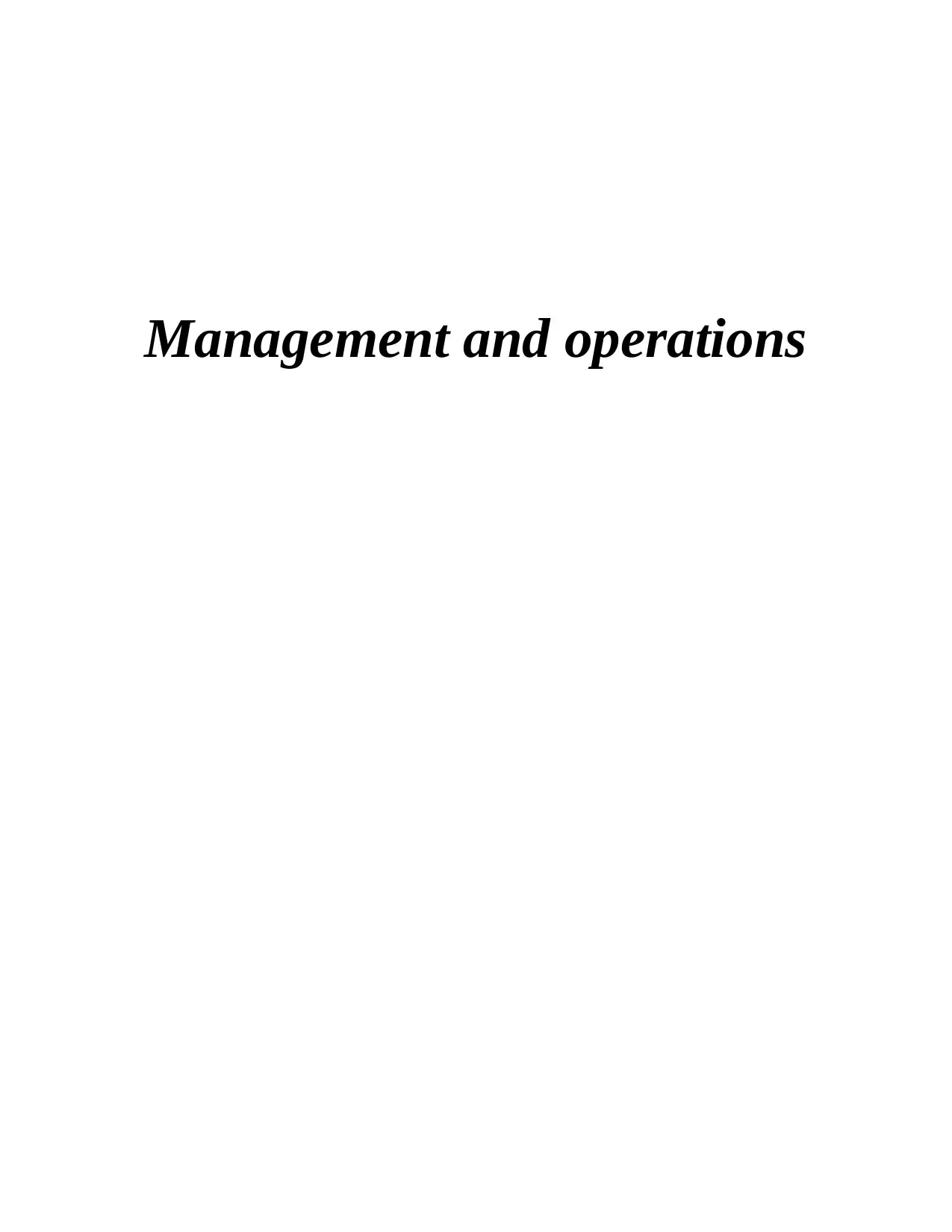
Management and operations
Paraphrase This Document
Need a fresh take? Get an instant paraphrase of this document with our AI Paraphraser
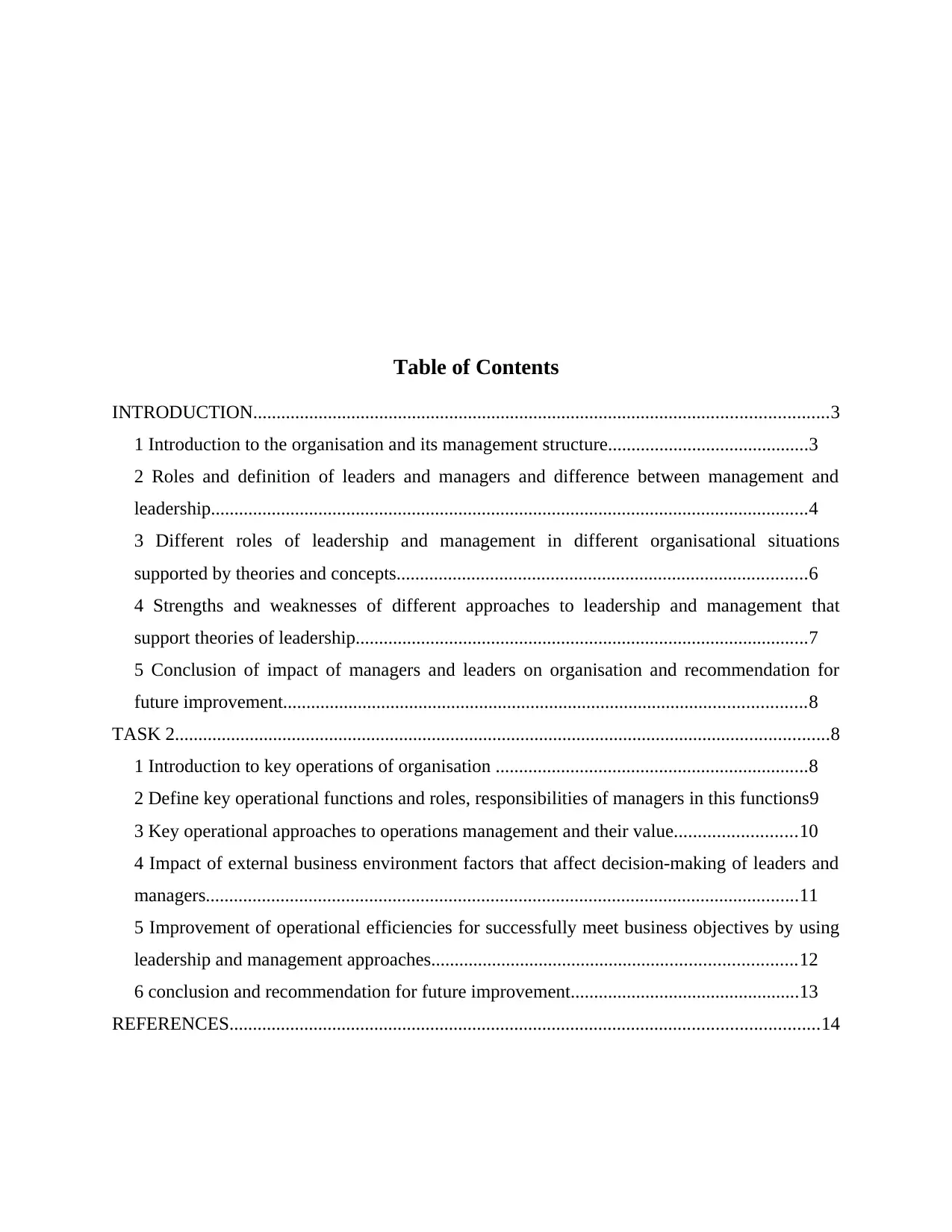
Table of Contents
INTRODUCTION...........................................................................................................................3
1 Introduction to the organisation and its management structure...........................................3
2 Roles and definition of leaders and managers and difference between management and
leadership................................................................................................................................4
3 Different roles of leadership and management in different organisational situations
supported by theories and concepts........................................................................................6
4 Strengths and weaknesses of different approaches to leadership and management that
support theories of leadership.................................................................................................7
5 Conclusion of impact of managers and leaders on organisation and recommendation for
future improvement................................................................................................................8
TASK 2............................................................................................................................................8
1 Introduction to key operations of organisation ...................................................................8
2 Define key operational functions and roles, responsibilities of managers in this functions9
3 Key operational approaches to operations management and their value..........................10
4 Impact of external business environment factors that affect decision-making of leaders and
managers...............................................................................................................................11
5 Improvement of operational efficiencies for successfully meet business objectives by using
leadership and management approaches..............................................................................12
6 conclusion and recommendation for future improvement.................................................13
REFERENCES..............................................................................................................................14
INTRODUCTION...........................................................................................................................3
1 Introduction to the organisation and its management structure...........................................3
2 Roles and definition of leaders and managers and difference between management and
leadership................................................................................................................................4
3 Different roles of leadership and management in different organisational situations
supported by theories and concepts........................................................................................6
4 Strengths and weaknesses of different approaches to leadership and management that
support theories of leadership.................................................................................................7
5 Conclusion of impact of managers and leaders on organisation and recommendation for
future improvement................................................................................................................8
TASK 2............................................................................................................................................8
1 Introduction to key operations of organisation ...................................................................8
2 Define key operational functions and roles, responsibilities of managers in this functions9
3 Key operational approaches to operations management and their value..........................10
4 Impact of external business environment factors that affect decision-making of leaders and
managers...............................................................................................................................11
5 Improvement of operational efficiencies for successfully meet business objectives by using
leadership and management approaches..............................................................................12
6 conclusion and recommendation for future improvement.................................................13
REFERENCES..............................................................................................................................14
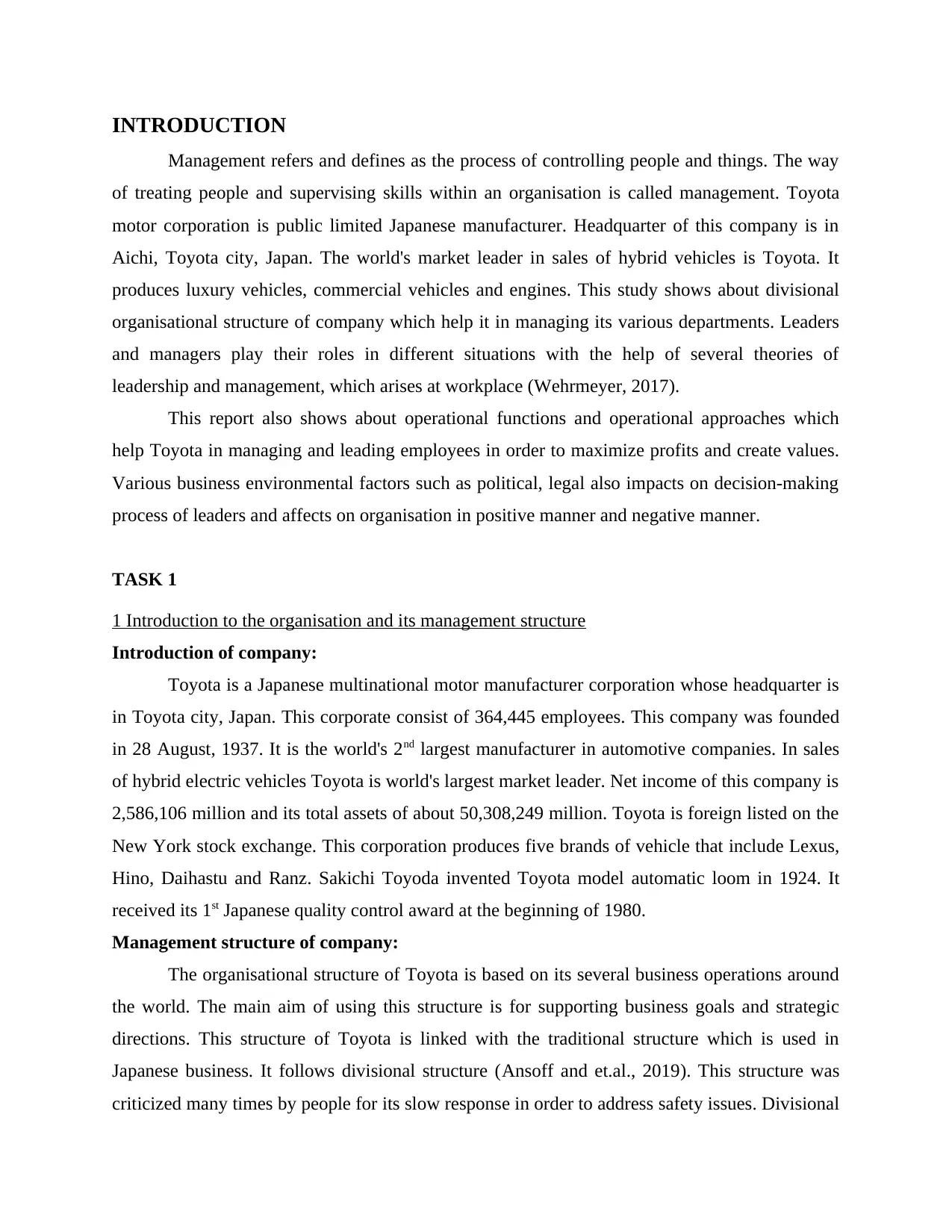
INTRODUCTION
Management refers and defines as the process of controlling people and things. The way
of treating people and supervising skills within an organisation is called management. Toyota
motor corporation is public limited Japanese manufacturer. Headquarter of this company is in
Aichi, Toyota city, Japan. The world's market leader in sales of hybrid vehicles is Toyota. It
produces luxury vehicles, commercial vehicles and engines. This study shows about divisional
organisational structure of company which help it in managing its various departments. Leaders
and managers play their roles in different situations with the help of several theories of
leadership and management, which arises at workplace (Wehrmeyer, 2017).
This report also shows about operational functions and operational approaches which
help Toyota in managing and leading employees in order to maximize profits and create values.
Various business environmental factors such as political, legal also impacts on decision-making
process of leaders and affects on organisation in positive manner and negative manner.
TASK 1
1 Introduction to the organisation and its management structure
Introduction of company:
Toyota is a Japanese multinational motor manufacturer corporation whose headquarter is
in Toyota city, Japan. This corporate consist of 364,445 employees. This company was founded
in 28 August, 1937. It is the world's 2nd largest manufacturer in automotive companies. In sales
of hybrid electric vehicles Toyota is world's largest market leader. Net income of this company is
2,586,106 million and its total assets of about 50,308,249 million. Toyota is foreign listed on the
New York stock exchange. This corporation produces five brands of vehicle that include Lexus,
Hino, Daihastu and Ranz. Sakichi Toyoda invented Toyota model automatic loom in 1924. It
received its 1st Japanese quality control award at the beginning of 1980.
Management structure of company:
The organisational structure of Toyota is based on its several business operations around
the world. The main aim of using this structure is for supporting business goals and strategic
directions. This structure of Toyota is linked with the traditional structure which is used in
Japanese business. It follows divisional structure (Ansoff and et.al., 2019). This structure was
criticized many times by people for its slow response in order to address safety issues. Divisional
Management refers and defines as the process of controlling people and things. The way
of treating people and supervising skills within an organisation is called management. Toyota
motor corporation is public limited Japanese manufacturer. Headquarter of this company is in
Aichi, Toyota city, Japan. The world's market leader in sales of hybrid vehicles is Toyota. It
produces luxury vehicles, commercial vehicles and engines. This study shows about divisional
organisational structure of company which help it in managing its various departments. Leaders
and managers play their roles in different situations with the help of several theories of
leadership and management, which arises at workplace (Wehrmeyer, 2017).
This report also shows about operational functions and operational approaches which
help Toyota in managing and leading employees in order to maximize profits and create values.
Various business environmental factors such as political, legal also impacts on decision-making
process of leaders and affects on organisation in positive manner and negative manner.
TASK 1
1 Introduction to the organisation and its management structure
Introduction of company:
Toyota is a Japanese multinational motor manufacturer corporation whose headquarter is
in Toyota city, Japan. This corporate consist of 364,445 employees. This company was founded
in 28 August, 1937. It is the world's 2nd largest manufacturer in automotive companies. In sales
of hybrid electric vehicles Toyota is world's largest market leader. Net income of this company is
2,586,106 million and its total assets of about 50,308,249 million. Toyota is foreign listed on the
New York stock exchange. This corporation produces five brands of vehicle that include Lexus,
Hino, Daihastu and Ranz. Sakichi Toyoda invented Toyota model automatic loom in 1924. It
received its 1st Japanese quality control award at the beginning of 1980.
Management structure of company:
The organisational structure of Toyota is based on its several business operations around
the world. The main aim of using this structure is for supporting business goals and strategic
directions. This structure of Toyota is linked with the traditional structure which is used in
Japanese business. It follows divisional structure (Ansoff and et.al., 2019). This structure was
criticized many times by people for its slow response in order to address safety issues. Divisional
⊘ This is a preview!⊘
Do you want full access?
Subscribe today to unlock all pages.

Trusted by 1+ million students worldwide
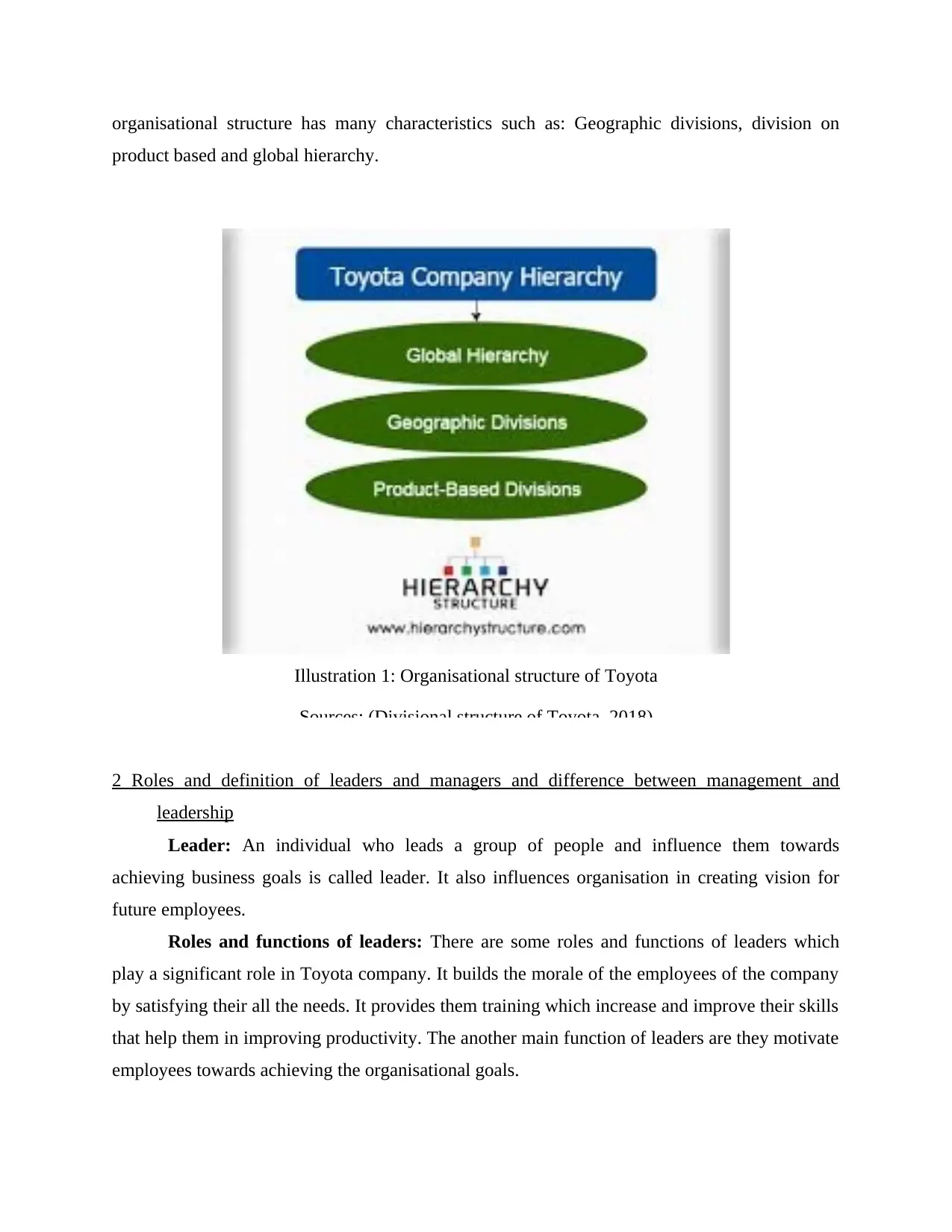
organisational structure has many characteristics such as: Geographic divisions, division on
product based and global hierarchy.
2 Roles and definition of leaders and managers and difference between management and
leadership
Leader: An individual who leads a group of people and influence them towards
achieving business goals is called leader. It also influences organisation in creating vision for
future employees.
Roles and functions of leaders: There are some roles and functions of leaders which
play a significant role in Toyota company. It builds the morale of the employees of the company
by satisfying their all the needs. It provides them training which increase and improve their skills
that help them in improving productivity. The another main function of leaders are they motivate
employees towards achieving the organisational goals.
Illustration 1: Organisational structure of Toyota
Sources: (Divisional structure of Toyota, 2018)
product based and global hierarchy.
2 Roles and definition of leaders and managers and difference between management and
leadership
Leader: An individual who leads a group of people and influence them towards
achieving business goals is called leader. It also influences organisation in creating vision for
future employees.
Roles and functions of leaders: There are some roles and functions of leaders which
play a significant role in Toyota company. It builds the morale of the employees of the company
by satisfying their all the needs. It provides them training which increase and improve their skills
that help them in improving productivity. The another main function of leaders are they motivate
employees towards achieving the organisational goals.
Illustration 1: Organisational structure of Toyota
Sources: (Divisional structure of Toyota, 2018)
Paraphrase This Document
Need a fresh take? Get an instant paraphrase of this document with our AI Paraphraser
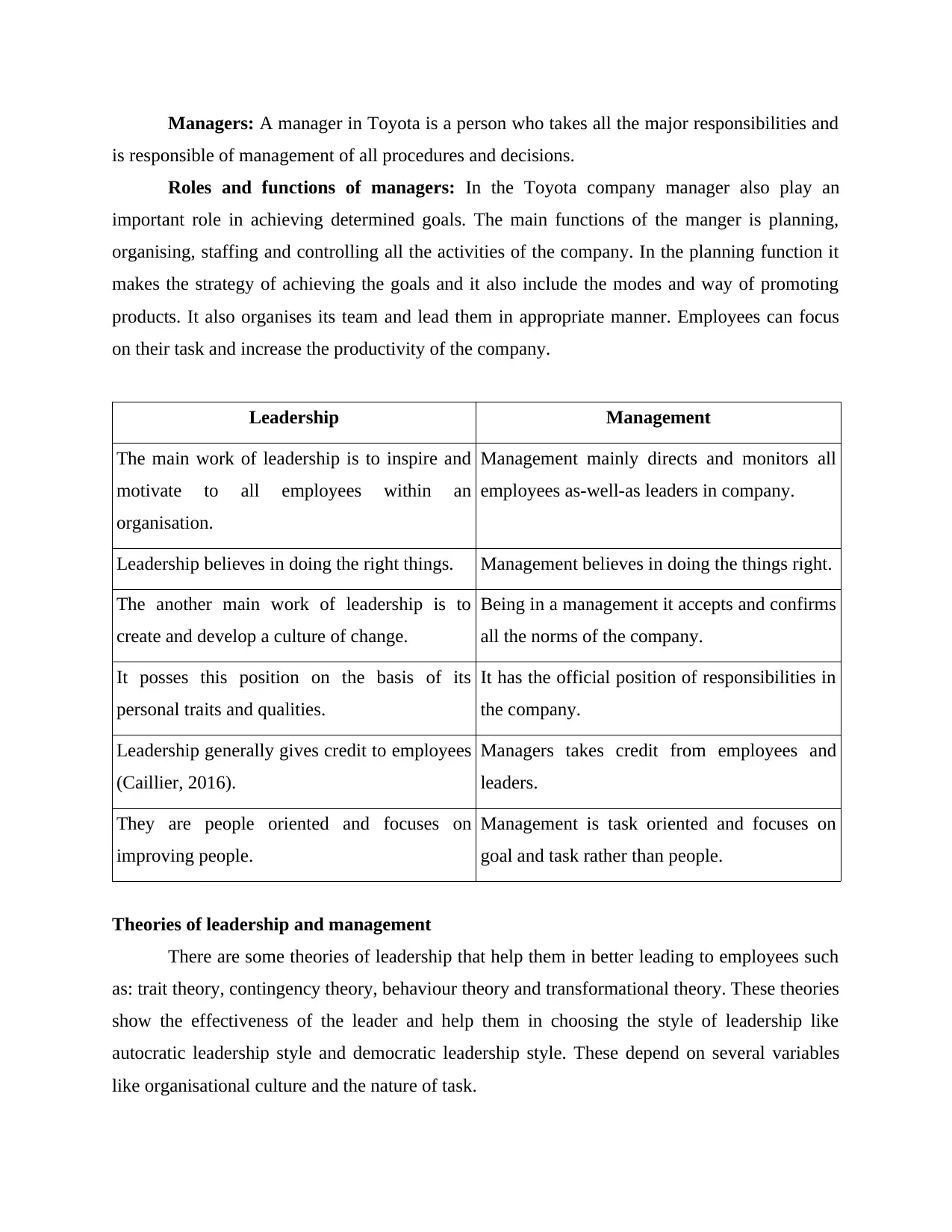
Managers: A manager in Toyota is a person who takes all the major responsibilities and
is responsible of management of all procedures and decisions.
Roles and functions of managers: In the Toyota company manager also play an
important role in achieving determined goals. The main functions of the manger is planning,
organising, staffing and controlling all the activities of the company. In the planning function it
makes the strategy of achieving the goals and it also include the modes and way of promoting
products. It also organises its team and lead them in appropriate manner. Employees can focus
on their task and increase the productivity of the company.
Leadership Management
The main work of leadership is to inspire and
motivate to all employees within an
organisation.
Management mainly directs and monitors all
employees as-well-as leaders in company.
Leadership believes in doing the right things. Management believes in doing the things right.
The another main work of leadership is to
create and develop a culture of change.
Being in a management it accepts and confirms
all the norms of the company.
It posses this position on the basis of its
personal traits and qualities.
It has the official position of responsibilities in
the company.
Leadership generally gives credit to employees
(Caillier, 2016).
Managers takes credit from employees and
leaders.
They are people oriented and focuses on
improving people.
Management is task oriented and focuses on
goal and task rather than people.
Theories of leadership and management
There are some theories of leadership that help them in better leading to employees such
as: trait theory, contingency theory, behaviour theory and transformational theory. These theories
show the effectiveness of the leader and help them in choosing the style of leadership like
autocratic leadership style and democratic leadership style. These depend on several variables
like organisational culture and the nature of task.
is responsible of management of all procedures and decisions.
Roles and functions of managers: In the Toyota company manager also play an
important role in achieving determined goals. The main functions of the manger is planning,
organising, staffing and controlling all the activities of the company. In the planning function it
makes the strategy of achieving the goals and it also include the modes and way of promoting
products. It also organises its team and lead them in appropriate manner. Employees can focus
on their task and increase the productivity of the company.
Leadership Management
The main work of leadership is to inspire and
motivate to all employees within an
organisation.
Management mainly directs and monitors all
employees as-well-as leaders in company.
Leadership believes in doing the right things. Management believes in doing the things right.
The another main work of leadership is to
create and develop a culture of change.
Being in a management it accepts and confirms
all the norms of the company.
It posses this position on the basis of its
personal traits and qualities.
It has the official position of responsibilities in
the company.
Leadership generally gives credit to employees
(Caillier, 2016).
Managers takes credit from employees and
leaders.
They are people oriented and focuses on
improving people.
Management is task oriented and focuses on
goal and task rather than people.
Theories of leadership and management
There are some theories of leadership that help them in better leading to employees such
as: trait theory, contingency theory, behaviour theory and transformational theory. These theories
show the effectiveness of the leader and help them in choosing the style of leadership like
autocratic leadership style and democratic leadership style. These depend on several variables
like organisational culture and the nature of task.
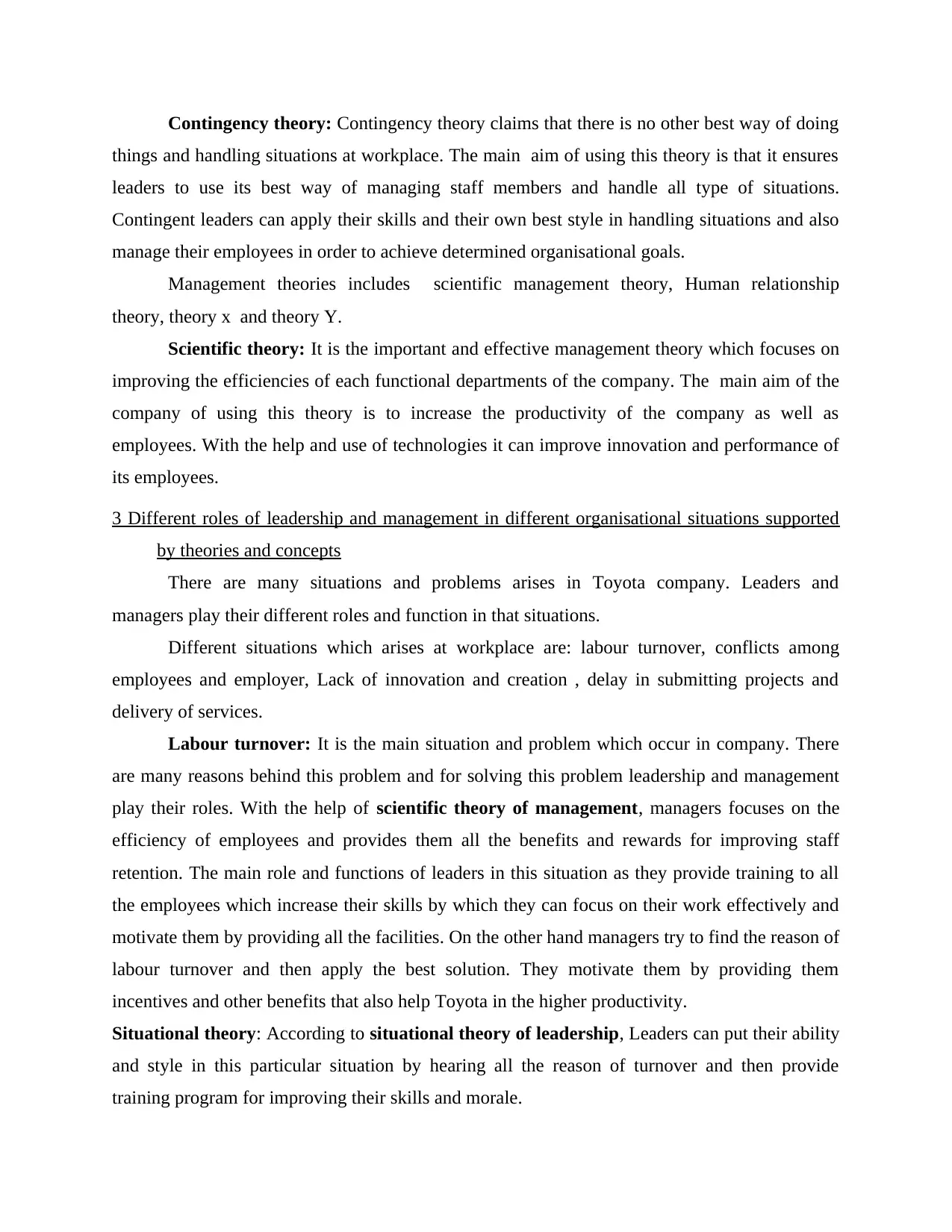
Contingency theory: Contingency theory claims that there is no other best way of doing
things and handling situations at workplace. The main aim of using this theory is that it ensures
leaders to use its best way of managing staff members and handle all type of situations.
Contingent leaders can apply their skills and their own best style in handling situations and also
manage their employees in order to achieve determined organisational goals.
Management theories includes scientific management theory, Human relationship
theory, theory x and theory Y.
Scientific theory: It is the important and effective management theory which focuses on
improving the efficiencies of each functional departments of the company. The main aim of the
company of using this theory is to increase the productivity of the company as well as
employees. With the help and use of technologies it can improve innovation and performance of
its employees.
3 Different roles of leadership and management in different organisational situations supported
by theories and concepts
There are many situations and problems arises in Toyota company. Leaders and
managers play their different roles and function in that situations.
Different situations which arises at workplace are: labour turnover, conflicts among
employees and employer, Lack of innovation and creation , delay in submitting projects and
delivery of services.
Labour turnover: It is the main situation and problem which occur in company. There
are many reasons behind this problem and for solving this problem leadership and management
play their roles. With the help of scientific theory of management, managers focuses on the
efficiency of employees and provides them all the benefits and rewards for improving staff
retention. The main role and functions of leaders in this situation as they provide training to all
the employees which increase their skills by which they can focus on their work effectively and
motivate them by providing all the facilities. On the other hand managers try to find the reason of
labour turnover and then apply the best solution. They motivate them by providing them
incentives and other benefits that also help Toyota in the higher productivity.
Situational theory: According to situational theory of leadership, Leaders can put their ability
and style in this particular situation by hearing all the reason of turnover and then provide
training program for improving their skills and morale.
things and handling situations at workplace. The main aim of using this theory is that it ensures
leaders to use its best way of managing staff members and handle all type of situations.
Contingent leaders can apply their skills and their own best style in handling situations and also
manage their employees in order to achieve determined organisational goals.
Management theories includes scientific management theory, Human relationship
theory, theory x and theory Y.
Scientific theory: It is the important and effective management theory which focuses on
improving the efficiencies of each functional departments of the company. The main aim of the
company of using this theory is to increase the productivity of the company as well as
employees. With the help and use of technologies it can improve innovation and performance of
its employees.
3 Different roles of leadership and management in different organisational situations supported
by theories and concepts
There are many situations and problems arises in Toyota company. Leaders and
managers play their different roles and function in that situations.
Different situations which arises at workplace are: labour turnover, conflicts among
employees and employer, Lack of innovation and creation , delay in submitting projects and
delivery of services.
Labour turnover: It is the main situation and problem which occur in company. There
are many reasons behind this problem and for solving this problem leadership and management
play their roles. With the help of scientific theory of management, managers focuses on the
efficiency of employees and provides them all the benefits and rewards for improving staff
retention. The main role and functions of leaders in this situation as they provide training to all
the employees which increase their skills by which they can focus on their work effectively and
motivate them by providing all the facilities. On the other hand managers try to find the reason of
labour turnover and then apply the best solution. They motivate them by providing them
incentives and other benefits that also help Toyota in the higher productivity.
Situational theory: According to situational theory of leadership, Leaders can put their ability
and style in this particular situation by hearing all the reason of turnover and then provide
training program for improving their skills and morale.
⊘ This is a preview!⊘
Do you want full access?
Subscribe today to unlock all pages.

Trusted by 1+ million students worldwide
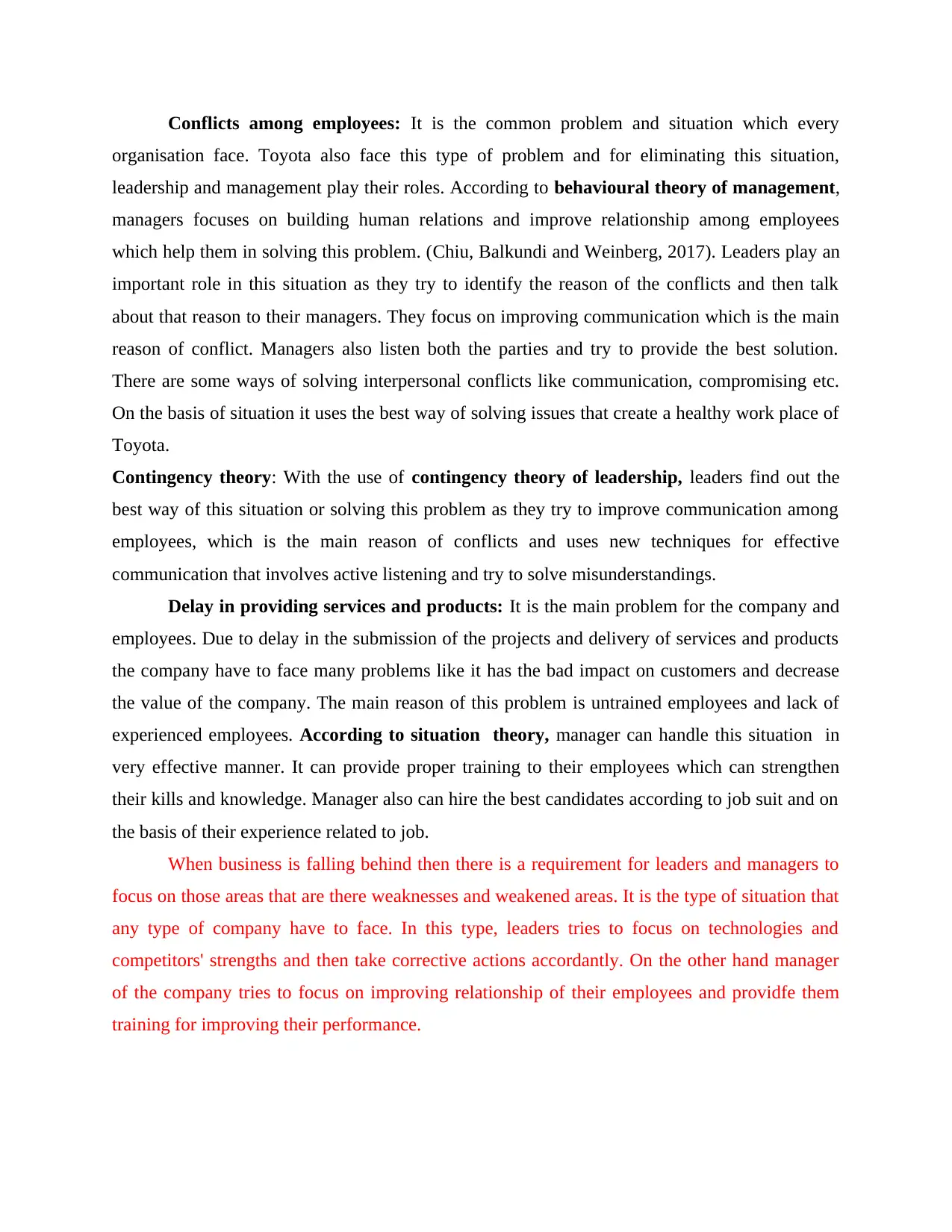
Conflicts among employees: It is the common problem and situation which every
organisation face. Toyota also face this type of problem and for eliminating this situation,
leadership and management play their roles. According to behavioural theory of management,
managers focuses on building human relations and improve relationship among employees
which help them in solving this problem. (Chiu, Balkundi and Weinberg, 2017). Leaders play an
important role in this situation as they try to identify the reason of the conflicts and then talk
about that reason to their managers. They focus on improving communication which is the main
reason of conflict. Managers also listen both the parties and try to provide the best solution.
There are some ways of solving interpersonal conflicts like communication, compromising etc.
On the basis of situation it uses the best way of solving issues that create a healthy work place of
Toyota.
Contingency theory: With the use of contingency theory of leadership, leaders find out the
best way of this situation or solving this problem as they try to improve communication among
employees, which is the main reason of conflicts and uses new techniques for effective
communication that involves active listening and try to solve misunderstandings.
Delay in providing services and products: It is the main problem for the company and
employees. Due to delay in the submission of the projects and delivery of services and products
the company have to face many problems like it has the bad impact on customers and decrease
the value of the company. The main reason of this problem is untrained employees and lack of
experienced employees. According to situation theory, manager can handle this situation in
very effective manner. It can provide proper training to their employees which can strengthen
their kills and knowledge. Manager also can hire the best candidates according to job suit and on
the basis of their experience related to job.
When business is falling behind then there is a requirement for leaders and managers to
focus on those areas that are there weaknesses and weakened areas. It is the type of situation that
any type of company have to face. In this type, leaders tries to focus on technologies and
competitors' strengths and then take corrective actions accordantly. On the other hand manager
of the company tries to focus on improving relationship of their employees and providfe them
training for improving their performance.
organisation face. Toyota also face this type of problem and for eliminating this situation,
leadership and management play their roles. According to behavioural theory of management,
managers focuses on building human relations and improve relationship among employees
which help them in solving this problem. (Chiu, Balkundi and Weinberg, 2017). Leaders play an
important role in this situation as they try to identify the reason of the conflicts and then talk
about that reason to their managers. They focus on improving communication which is the main
reason of conflict. Managers also listen both the parties and try to provide the best solution.
There are some ways of solving interpersonal conflicts like communication, compromising etc.
On the basis of situation it uses the best way of solving issues that create a healthy work place of
Toyota.
Contingency theory: With the use of contingency theory of leadership, leaders find out the
best way of this situation or solving this problem as they try to improve communication among
employees, which is the main reason of conflicts and uses new techniques for effective
communication that involves active listening and try to solve misunderstandings.
Delay in providing services and products: It is the main problem for the company and
employees. Due to delay in the submission of the projects and delivery of services and products
the company have to face many problems like it has the bad impact on customers and decrease
the value of the company. The main reason of this problem is untrained employees and lack of
experienced employees. According to situation theory, manager can handle this situation in
very effective manner. It can provide proper training to their employees which can strengthen
their kills and knowledge. Manager also can hire the best candidates according to job suit and on
the basis of their experience related to job.
When business is falling behind then there is a requirement for leaders and managers to
focus on those areas that are there weaknesses and weakened areas. It is the type of situation that
any type of company have to face. In this type, leaders tries to focus on technologies and
competitors' strengths and then take corrective actions accordantly. On the other hand manager
of the company tries to focus on improving relationship of their employees and providfe them
training for improving their performance.
Paraphrase This Document
Need a fresh take? Get an instant paraphrase of this document with our AI Paraphraser
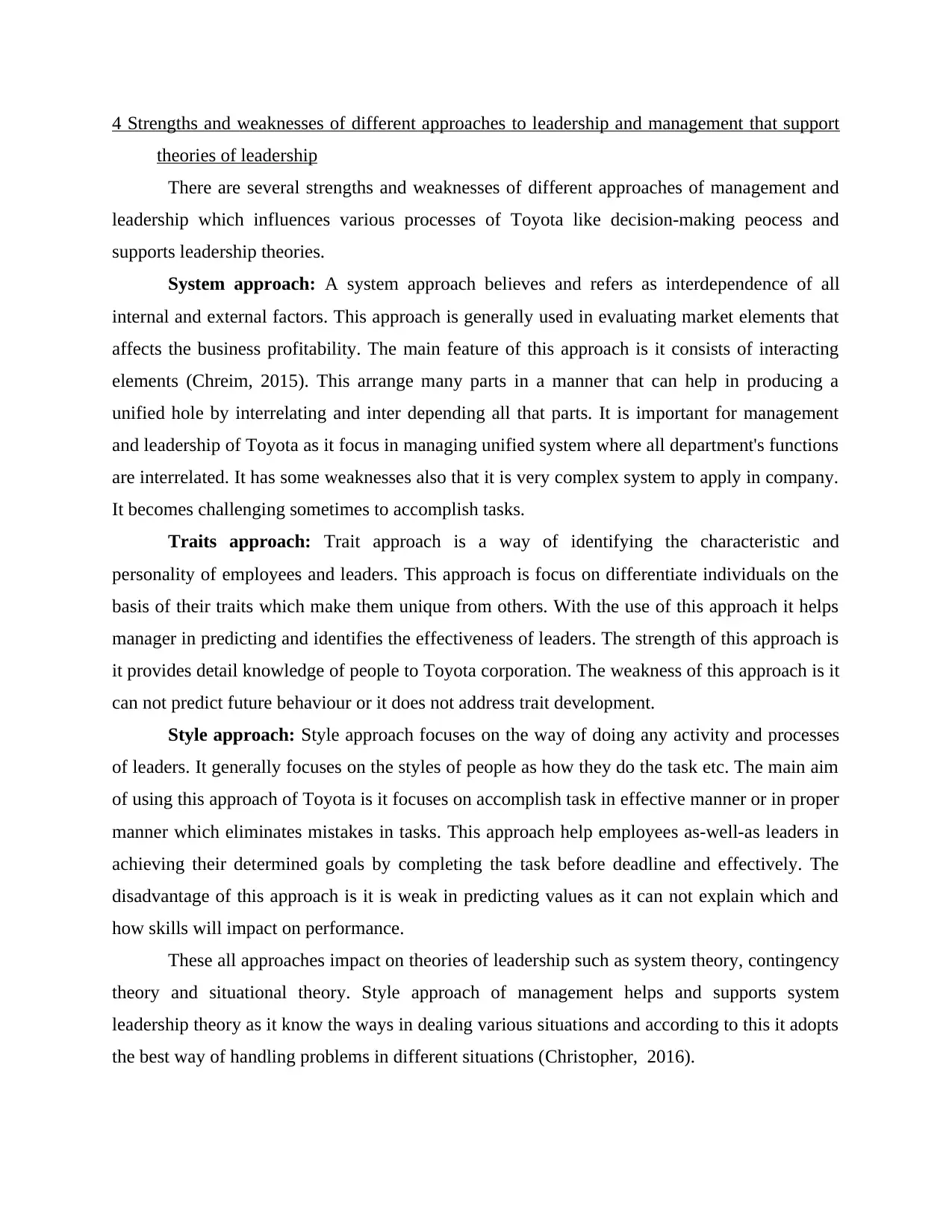
4 Strengths and weaknesses of different approaches to leadership and management that support
theories of leadership
There are several strengths and weaknesses of different approaches of management and
leadership which influences various processes of Toyota like decision-making peocess and
supports leadership theories.
System approach: A system approach believes and refers as interdependence of all
internal and external factors. This approach is generally used in evaluating market elements that
affects the business profitability. The main feature of this approach is it consists of interacting
elements (Chreim, 2015). This arrange many parts in a manner that can help in producing a
unified hole by interrelating and inter depending all that parts. It is important for management
and leadership of Toyota as it focus in managing unified system where all department's functions
are interrelated. It has some weaknesses also that it is very complex system to apply in company.
It becomes challenging sometimes to accomplish tasks.
Traits approach: Trait approach is a way of identifying the characteristic and
personality of employees and leaders. This approach is focus on differentiate individuals on the
basis of their traits which make them unique from others. With the use of this approach it helps
manager in predicting and identifies the effectiveness of leaders. The strength of this approach is
it provides detail knowledge of people to Toyota corporation. The weakness of this approach is it
can not predict future behaviour or it does not address trait development.
Style approach: Style approach focuses on the way of doing any activity and processes
of leaders. It generally focuses on the styles of people as how they do the task etc. The main aim
of using this approach of Toyota is it focuses on accomplish task in effective manner or in proper
manner which eliminates mistakes in tasks. This approach help employees as-well-as leaders in
achieving their determined goals by completing the task before deadline and effectively. The
disadvantage of this approach is it is weak in predicting values as it can not explain which and
how skills will impact on performance.
These all approaches impact on theories of leadership such as system theory, contingency
theory and situational theory. Style approach of management helps and supports system
leadership theory as it know the ways in dealing various situations and according to this it adopts
the best way of handling problems in different situations (Christopher, 2016).
theories of leadership
There are several strengths and weaknesses of different approaches of management and
leadership which influences various processes of Toyota like decision-making peocess and
supports leadership theories.
System approach: A system approach believes and refers as interdependence of all
internal and external factors. This approach is generally used in evaluating market elements that
affects the business profitability. The main feature of this approach is it consists of interacting
elements (Chreim, 2015). This arrange many parts in a manner that can help in producing a
unified hole by interrelating and inter depending all that parts. It is important for management
and leadership of Toyota as it focus in managing unified system where all department's functions
are interrelated. It has some weaknesses also that it is very complex system to apply in company.
It becomes challenging sometimes to accomplish tasks.
Traits approach: Trait approach is a way of identifying the characteristic and
personality of employees and leaders. This approach is focus on differentiate individuals on the
basis of their traits which make them unique from others. With the use of this approach it helps
manager in predicting and identifies the effectiveness of leaders. The strength of this approach is
it provides detail knowledge of people to Toyota corporation. The weakness of this approach is it
can not predict future behaviour or it does not address trait development.
Style approach: Style approach focuses on the way of doing any activity and processes
of leaders. It generally focuses on the styles of people as how they do the task etc. The main aim
of using this approach of Toyota is it focuses on accomplish task in effective manner or in proper
manner which eliminates mistakes in tasks. This approach help employees as-well-as leaders in
achieving their determined goals by completing the task before deadline and effectively. The
disadvantage of this approach is it is weak in predicting values as it can not explain which and
how skills will impact on performance.
These all approaches impact on theories of leadership such as system theory, contingency
theory and situational theory. Style approach of management helps and supports system
leadership theory as it know the ways in dealing various situations and according to this it adopts
the best way of handling problems in different situations (Christopher, 2016).
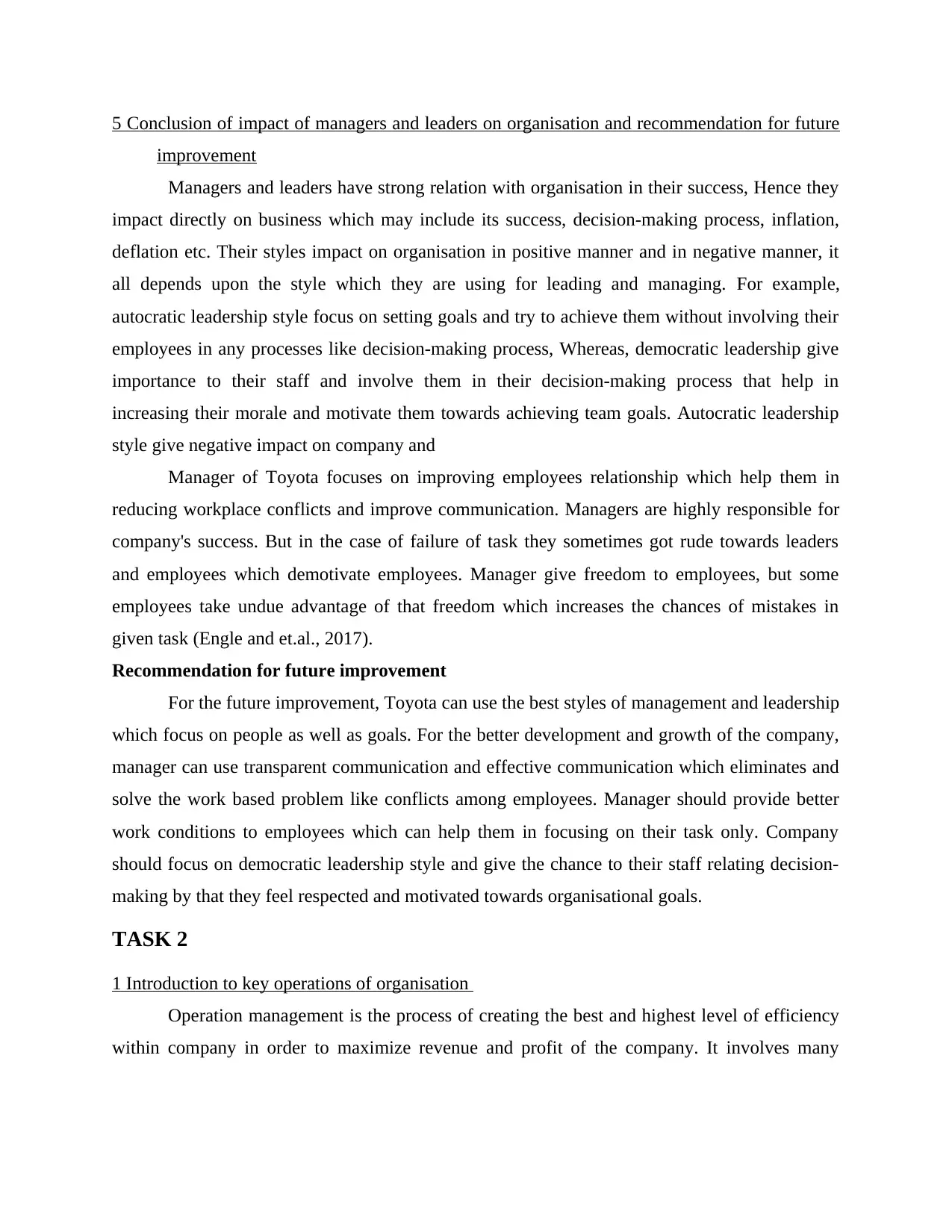
5 Conclusion of impact of managers and leaders on organisation and recommendation for future
improvement
Managers and leaders have strong relation with organisation in their success, Hence they
impact directly on business which may include its success, decision-making process, inflation,
deflation etc. Their styles impact on organisation in positive manner and in negative manner, it
all depends upon the style which they are using for leading and managing. For example,
autocratic leadership style focus on setting goals and try to achieve them without involving their
employees in any processes like decision-making process, Whereas, democratic leadership give
importance to their staff and involve them in their decision-making process that help in
increasing their morale and motivate them towards achieving team goals. Autocratic leadership
style give negative impact on company and
Manager of Toyota focuses on improving employees relationship which help them in
reducing workplace conflicts and improve communication. Managers are highly responsible for
company's success. But in the case of failure of task they sometimes got rude towards leaders
and employees which demotivate employees. Manager give freedom to employees, but some
employees take undue advantage of that freedom which increases the chances of mistakes in
given task (Engle and et.al., 2017).
Recommendation for future improvement
For the future improvement, Toyota can use the best styles of management and leadership
which focus on people as well as goals. For the better development and growth of the company,
manager can use transparent communication and effective communication which eliminates and
solve the work based problem like conflicts among employees. Manager should provide better
work conditions to employees which can help them in focusing on their task only. Company
should focus on democratic leadership style and give the chance to their staff relating decision-
making by that they feel respected and motivated towards organisational goals.
TASK 2
1 Introduction to key operations of organisation
Operation management is the process of creating the best and highest level of efficiency
within company in order to maximize revenue and profit of the company. It involves many
improvement
Managers and leaders have strong relation with organisation in their success, Hence they
impact directly on business which may include its success, decision-making process, inflation,
deflation etc. Their styles impact on organisation in positive manner and in negative manner, it
all depends upon the style which they are using for leading and managing. For example,
autocratic leadership style focus on setting goals and try to achieve them without involving their
employees in any processes like decision-making process, Whereas, democratic leadership give
importance to their staff and involve them in their decision-making process that help in
increasing their morale and motivate them towards achieving team goals. Autocratic leadership
style give negative impact on company and
Manager of Toyota focuses on improving employees relationship which help them in
reducing workplace conflicts and improve communication. Managers are highly responsible for
company's success. But in the case of failure of task they sometimes got rude towards leaders
and employees which demotivate employees. Manager give freedom to employees, but some
employees take undue advantage of that freedom which increases the chances of mistakes in
given task (Engle and et.al., 2017).
Recommendation for future improvement
For the future improvement, Toyota can use the best styles of management and leadership
which focus on people as well as goals. For the better development and growth of the company,
manager can use transparent communication and effective communication which eliminates and
solve the work based problem like conflicts among employees. Manager should provide better
work conditions to employees which can help them in focusing on their task only. Company
should focus on democratic leadership style and give the chance to their staff relating decision-
making by that they feel respected and motivated towards organisational goals.
TASK 2
1 Introduction to key operations of organisation
Operation management is the process of creating the best and highest level of efficiency
within company in order to maximize revenue and profit of the company. It involves many
⊘ This is a preview!⊘
Do you want full access?
Subscribe today to unlock all pages.

Trusted by 1+ million students worldwide
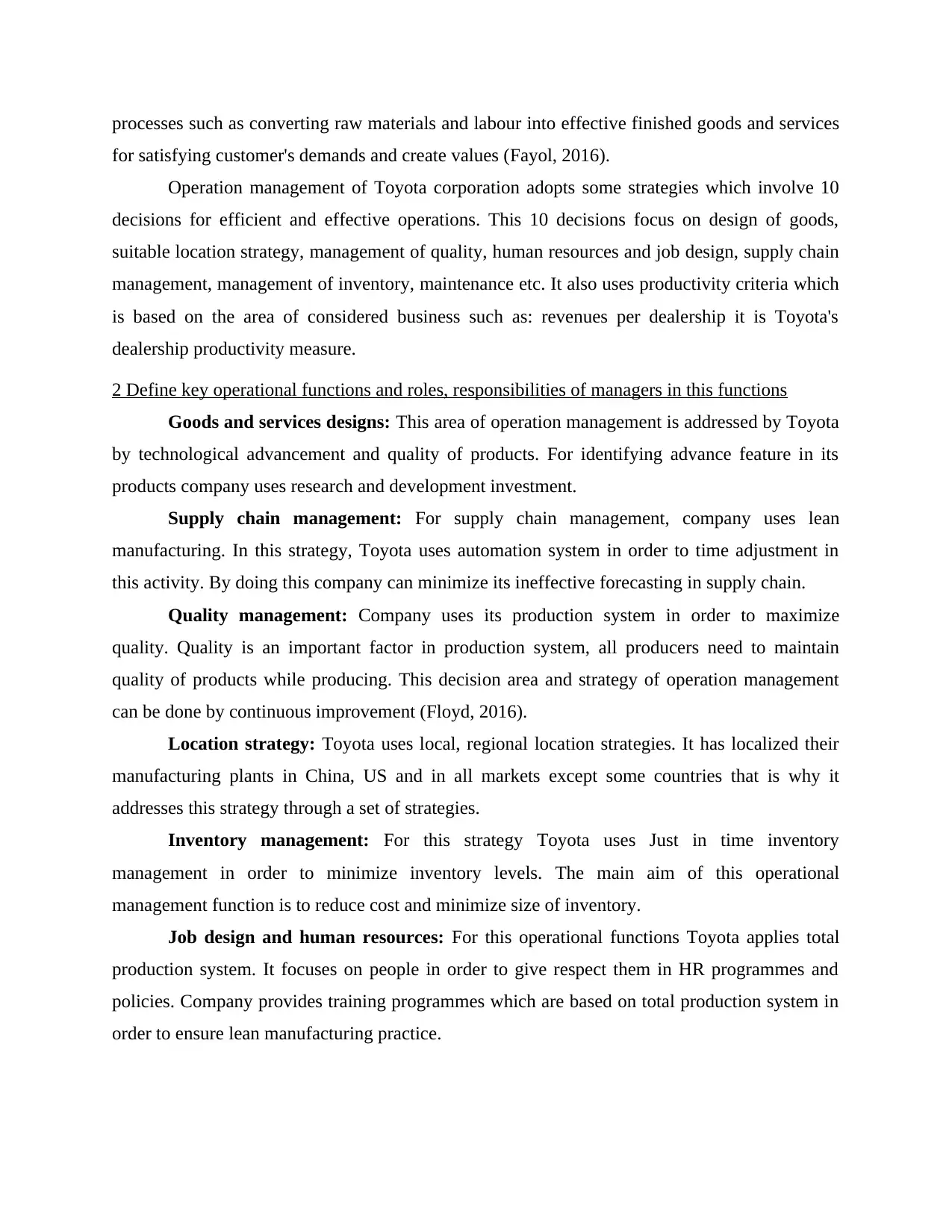
processes such as converting raw materials and labour into effective finished goods and services
for satisfying customer's demands and create values (Fayol, 2016).
Operation management of Toyota corporation adopts some strategies which involve 10
decisions for efficient and effective operations. This 10 decisions focus on design of goods,
suitable location strategy, management of quality, human resources and job design, supply chain
management, management of inventory, maintenance etc. It also uses productivity criteria which
is based on the area of considered business such as: revenues per dealership it is Toyota's
dealership productivity measure.
2 Define key operational functions and roles, responsibilities of managers in this functions
Goods and services designs: This area of operation management is addressed by Toyota
by technological advancement and quality of products. For identifying advance feature in its
products company uses research and development investment.
Supply chain management: For supply chain management, company uses lean
manufacturing. In this strategy, Toyota uses automation system in order to time adjustment in
this activity. By doing this company can minimize its ineffective forecasting in supply chain.
Quality management: Company uses its production system in order to maximize
quality. Quality is an important factor in production system, all producers need to maintain
quality of products while producing. This decision area and strategy of operation management
can be done by continuous improvement (Floyd, 2016).
Location strategy: Toyota uses local, regional location strategies. It has localized their
manufacturing plants in China, US and in all markets except some countries that is why it
addresses this strategy through a set of strategies.
Inventory management: For this strategy Toyota uses Just in time inventory
management in order to minimize inventory levels. The main aim of this operational
management function is to reduce cost and minimize size of inventory.
Job design and human resources: For this operational functions Toyota applies total
production system. It focuses on people in order to give respect them in HR programmes and
policies. Company provides training programmes which are based on total production system in
order to ensure lean manufacturing practice.
for satisfying customer's demands and create values (Fayol, 2016).
Operation management of Toyota corporation adopts some strategies which involve 10
decisions for efficient and effective operations. This 10 decisions focus on design of goods,
suitable location strategy, management of quality, human resources and job design, supply chain
management, management of inventory, maintenance etc. It also uses productivity criteria which
is based on the area of considered business such as: revenues per dealership it is Toyota's
dealership productivity measure.
2 Define key operational functions and roles, responsibilities of managers in this functions
Goods and services designs: This area of operation management is addressed by Toyota
by technological advancement and quality of products. For identifying advance feature in its
products company uses research and development investment.
Supply chain management: For supply chain management, company uses lean
manufacturing. In this strategy, Toyota uses automation system in order to time adjustment in
this activity. By doing this company can minimize its ineffective forecasting in supply chain.
Quality management: Company uses its production system in order to maximize
quality. Quality is an important factor in production system, all producers need to maintain
quality of products while producing. This decision area and strategy of operation management
can be done by continuous improvement (Floyd, 2016).
Location strategy: Toyota uses local, regional location strategies. It has localized their
manufacturing plants in China, US and in all markets except some countries that is why it
addresses this strategy through a set of strategies.
Inventory management: For this strategy Toyota uses Just in time inventory
management in order to minimize inventory levels. The main aim of this operational
management function is to reduce cost and minimize size of inventory.
Job design and human resources: For this operational functions Toyota applies total
production system. It focuses on people in order to give respect them in HR programmes and
policies. Company provides training programmes which are based on total production system in
order to ensure lean manufacturing practice.
Paraphrase This Document
Need a fresh take? Get an instant paraphrase of this document with our AI Paraphraser
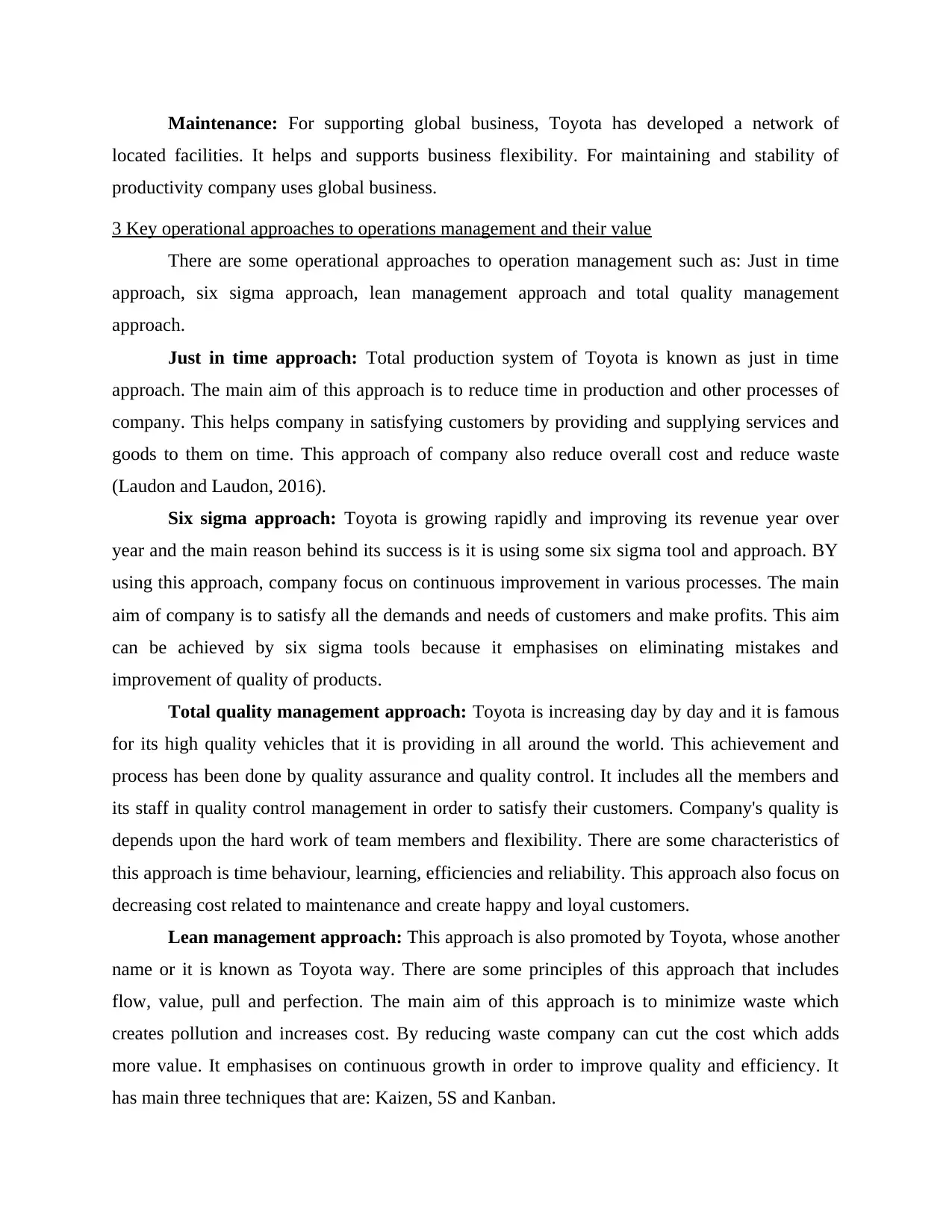
Maintenance: For supporting global business, Toyota has developed a network of
located facilities. It helps and supports business flexibility. For maintaining and stability of
productivity company uses global business.
3 Key operational approaches to operations management and their value
There are some operational approaches to operation management such as: Just in time
approach, six sigma approach, lean management approach and total quality management
approach.
Just in time approach: Total production system of Toyota is known as just in time
approach. The main aim of this approach is to reduce time in production and other processes of
company. This helps company in satisfying customers by providing and supplying services and
goods to them on time. This approach of company also reduce overall cost and reduce waste
(Laudon and Laudon, 2016).
Six sigma approach: Toyota is growing rapidly and improving its revenue year over
year and the main reason behind its success is it is using some six sigma tool and approach. BY
using this approach, company focus on continuous improvement in various processes. The main
aim of company is to satisfy all the demands and needs of customers and make profits. This aim
can be achieved by six sigma tools because it emphasises on eliminating mistakes and
improvement of quality of products.
Total quality management approach: Toyota is increasing day by day and it is famous
for its high quality vehicles that it is providing in all around the world. This achievement and
process has been done by quality assurance and quality control. It includes all the members and
its staff in quality control management in order to satisfy their customers. Company's quality is
depends upon the hard work of team members and flexibility. There are some characteristics of
this approach is time behaviour, learning, efficiencies and reliability. This approach also focus on
decreasing cost related to maintenance and create happy and loyal customers.
Lean management approach: This approach is also promoted by Toyota, whose another
name or it is known as Toyota way. There are some principles of this approach that includes
flow, value, pull and perfection. The main aim of this approach is to minimize waste which
creates pollution and increases cost. By reducing waste company can cut the cost which adds
more value. It emphasises on continuous growth in order to improve quality and efficiency. It
has main three techniques that are: Kaizen, 5S and Kanban.
located facilities. It helps and supports business flexibility. For maintaining and stability of
productivity company uses global business.
3 Key operational approaches to operations management and their value
There are some operational approaches to operation management such as: Just in time
approach, six sigma approach, lean management approach and total quality management
approach.
Just in time approach: Total production system of Toyota is known as just in time
approach. The main aim of this approach is to reduce time in production and other processes of
company. This helps company in satisfying customers by providing and supplying services and
goods to them on time. This approach of company also reduce overall cost and reduce waste
(Laudon and Laudon, 2016).
Six sigma approach: Toyota is growing rapidly and improving its revenue year over
year and the main reason behind its success is it is using some six sigma tool and approach. BY
using this approach, company focus on continuous improvement in various processes. The main
aim of company is to satisfy all the demands and needs of customers and make profits. This aim
can be achieved by six sigma tools because it emphasises on eliminating mistakes and
improvement of quality of products.
Total quality management approach: Toyota is increasing day by day and it is famous
for its high quality vehicles that it is providing in all around the world. This achievement and
process has been done by quality assurance and quality control. It includes all the members and
its staff in quality control management in order to satisfy their customers. Company's quality is
depends upon the hard work of team members and flexibility. There are some characteristics of
this approach is time behaviour, learning, efficiencies and reliability. This approach also focus on
decreasing cost related to maintenance and create happy and loyal customers.
Lean management approach: This approach is also promoted by Toyota, whose another
name or it is known as Toyota way. There are some principles of this approach that includes
flow, value, pull and perfection. The main aim of this approach is to minimize waste which
creates pollution and increases cost. By reducing waste company can cut the cost which adds
more value. It emphasises on continuous growth in order to improve quality and efficiency. It
has main three techniques that are: Kaizen, 5S and Kanban.
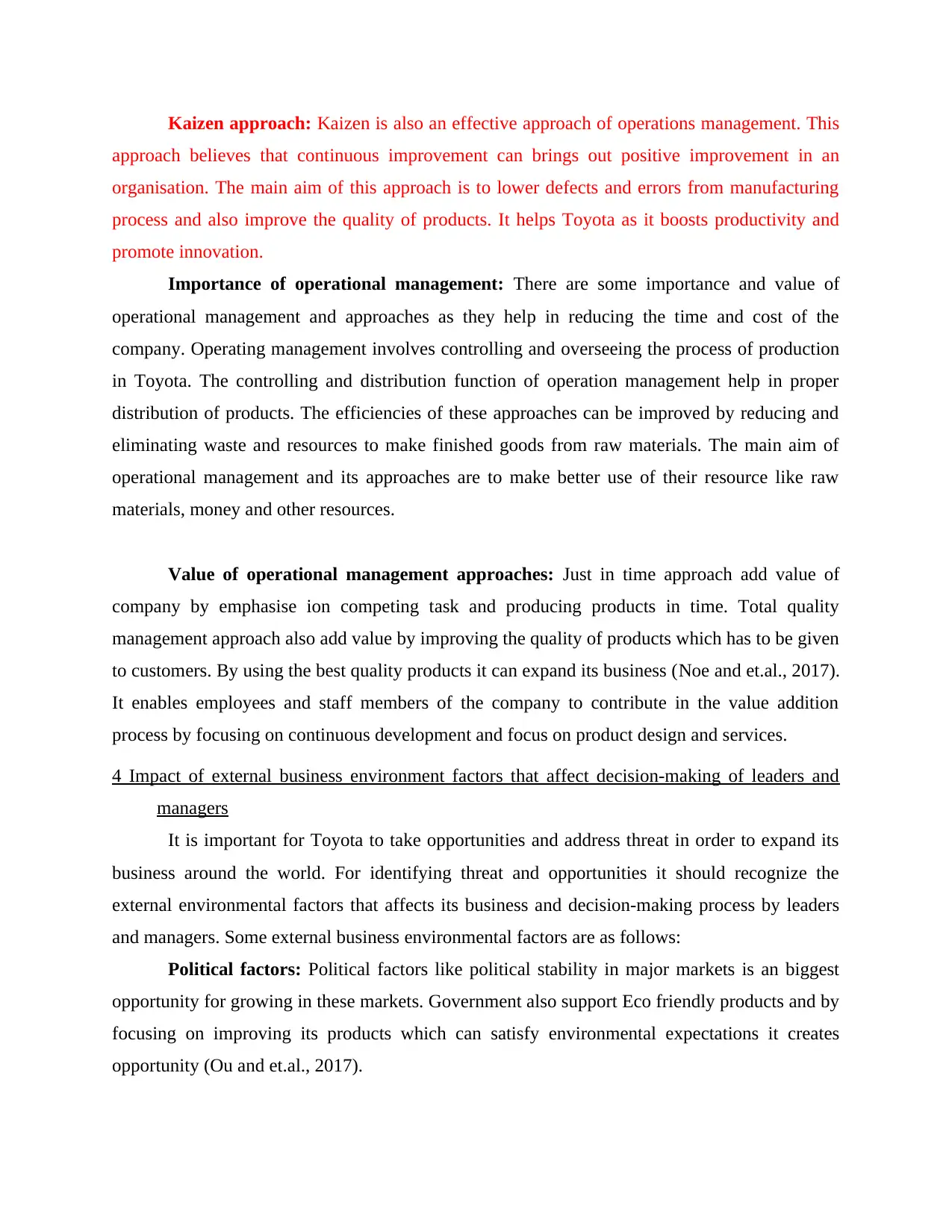
Kaizen approach: Kaizen is also an effective approach of operations management. This
approach believes that continuous improvement can brings out positive improvement in an
organisation. The main aim of this approach is to lower defects and errors from manufacturing
process and also improve the quality of products. It helps Toyota as it boosts productivity and
promote innovation.
Importance of operational management: There are some importance and value of
operational management and approaches as they help in reducing the time and cost of the
company. Operating management involves controlling and overseeing the process of production
in Toyota. The controlling and distribution function of operation management help in proper
distribution of products. The efficiencies of these approaches can be improved by reducing and
eliminating waste and resources to make finished goods from raw materials. The main aim of
operational management and its approaches are to make better use of their resource like raw
materials, money and other resources.
Value of operational management approaches: Just in time approach add value of
company by emphasise ion competing task and producing products in time. Total quality
management approach also add value by improving the quality of products which has to be given
to customers. By using the best quality products it can expand its business (Noe and et.al., 2017).
It enables employees and staff members of the company to contribute in the value addition
process by focusing on continuous development and focus on product design and services.
4 Impact of external business environment factors that affect decision-making of leaders and
managers
It is important for Toyota to take opportunities and address threat in order to expand its
business around the world. For identifying threat and opportunities it should recognize the
external environmental factors that affects its business and decision-making process by leaders
and managers. Some external business environmental factors are as follows:
Political factors: Political factors like political stability in major markets is an biggest
opportunity for growing in these markets. Government also support Eco friendly products and by
focusing on improving its products which can satisfy environmental expectations it creates
opportunity (Ou and et.al., 2017).
approach believes that continuous improvement can brings out positive improvement in an
organisation. The main aim of this approach is to lower defects and errors from manufacturing
process and also improve the quality of products. It helps Toyota as it boosts productivity and
promote innovation.
Importance of operational management: There are some importance and value of
operational management and approaches as they help in reducing the time and cost of the
company. Operating management involves controlling and overseeing the process of production
in Toyota. The controlling and distribution function of operation management help in proper
distribution of products. The efficiencies of these approaches can be improved by reducing and
eliminating waste and resources to make finished goods from raw materials. The main aim of
operational management and its approaches are to make better use of their resource like raw
materials, money and other resources.
Value of operational management approaches: Just in time approach add value of
company by emphasise ion competing task and producing products in time. Total quality
management approach also add value by improving the quality of products which has to be given
to customers. By using the best quality products it can expand its business (Noe and et.al., 2017).
It enables employees and staff members of the company to contribute in the value addition
process by focusing on continuous development and focus on product design and services.
4 Impact of external business environment factors that affect decision-making of leaders and
managers
It is important for Toyota to take opportunities and address threat in order to expand its
business around the world. For identifying threat and opportunities it should recognize the
external environmental factors that affects its business and decision-making process by leaders
and managers. Some external business environmental factors are as follows:
Political factors: Political factors like political stability in major markets is an biggest
opportunity for growing in these markets. Government also support Eco friendly products and by
focusing on improving its products which can satisfy environmental expectations it creates
opportunity (Ou and et.al., 2017).
⊘ This is a preview!⊘
Do you want full access?
Subscribe today to unlock all pages.

Trusted by 1+ million students worldwide
1 out of 17
Related Documents
Your All-in-One AI-Powered Toolkit for Academic Success.
+13062052269
info@desklib.com
Available 24*7 on WhatsApp / Email
![[object Object]](/_next/static/media/star-bottom.7253800d.svg)
Unlock your academic potential
Copyright © 2020–2025 A2Z Services. All Rights Reserved. Developed and managed by ZUCOL.





